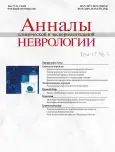Demyelinating CNS processes in late post-liver transplant period
- Authors: Salienko A.A.1, Syutkin V.E.1, Lisitskaya M.V.2, Kuznetsov D.V.3, Novruzbekov M.S.1
-
Affiliations:
- Sklifosovsky Research Institute for Emergency Medicine
- Lomonosov Moscow State University
- Moscow Scientific and Practical Center of Dermatology, Venerology and Cosmetology
- Issue: Vol 17, No 3 (2023)
- Pages: 83-87
- Section: Clinical analysis
- URL: https://journals.rcsi.science/2075-5473/article/view/253963
- DOI: https://doi.org/10.54101/ACEN.2023.3.10
- ID: 253963
Cite item
Full Text
Abstract
In solid organ recipients, post-transplant neurotoxicity of calcineurin inhibitors (CIs) can be manifested by brain and spinal cord demyelination with multiple sclerosis (MS)-like symptoms.
Here are presented two case reports of neurological MS-like symptoms in the long-term post-liver transplant period with different underlying causes.
CI neurotoxicity may resemble various neurological diseases, including MS. At the same time, liver transplant recipients can develop true MS regardless of the immunosuppressant use. In liver transplant recipients, adequate differential diagnosis of neurological complications avoids unnecessary medications and reverses severe neurological deficits by immunosuppressant conversion.
Full Text
##article.viewOnOriginalSite##About the authors
Anastasia A. Salienko
Sklifosovsky Research Institute for Emergency Medicine
Author for correspondence.
Email: salienko1@mail.ru
ORCID iD: 0000-0002-2732-684X
surgeon, Emergency operations unit, Moscow City Center for Liver Transplantation, Sklifosovsky Research Institute for Emergency Medicine, Moscow, Russia
Russian Federation, MoscowVladimir E. Syutkin
Sklifosovsky Research Institute for Emergency Medicine
Email: vladsyutkin@gmail.com
ORCID iD: 0000-0001-8391-5211
D. Sci. (Med.), leading researcher, Moscow City Center for Liver Transplantation, Sklifosovsky Research Institute for Emergency Medicine, Moscow, Russia
Russian Federation, MoscowMaria V. Lisitskaya
Lomonosov Moscow State University
Email: lissenok@inbox.ru
ORCID iD: 0000-0002-8402-7643
Cand. Sci. (Med.), radiologist, Department of X-ray diagnostics with CT and MRI rooms, Lomonosov Moscow State University, Moscow, Russia
Russian Federation, MoscowDenis V. Kuznetsov
Moscow Scientific and Practical Center of Dermatology, Venerology and Cosmetology
Email: doktor.nevrolog@mail.ru
ORCID iD: 0000-0002-8201-2376
neurologist, Moscow Scientific and Practical Center of Dermatology, Venerology and Cosmetology, Moscow, Russia
Russian Federation, MoscowMurad S. Novruzbekov
Sklifosovsky Research Institute for Emergency Medicine
Email: n.m.s@bk.ru
ORCID iD: 0000-0002-6362-7914
D. Sci. (Med.), Head, Scientific Department, Moscow City Center for Liver Transplantation, Sklifosovsky Research Institute for Emergency Medicine, Moscow, Russia
Russian Federation, MoscowReferences
- Rompianesi G., Montalti R., Cautero N. et al. Neurological complications after liver transplantation as a consequence of immunosuppression: univariate and multivariate analysis of risk factors. Transpl. Int. 2015;28(7):864–869. doi: 10.1111/tri.12564
- Zivković S.A. Neurologic complications after liver transplantation. World J. Hepatol. 2013;5(8):409–416. doi: 10.4254/wjh.v5.i8.409
- Цирульникова О.М., Сыркина А.В., Милосердов И.А. и др. Острые симптоматические судорожные приступы в раннем послеоперационном периоде трансплантации печени, почки. Вестник трансплантологии и искусственных органов. 2021;23(2):158–166. Tsirul’nikova O.M., Syrkina A.V., Miloserdov I.A. et al. Early postoperative seizures in liver and kidney recipients. Vestnik transplantologii i iskusstvennykh organov. 2021;23(2):158–166. (In Russ.). doi: 10.15825/1995-1191-2021-2-158-166
- Mueller A.R., Platz K.P., Bechstein W.O. et al. Neurotoxicity after orthotopic liver transplantation. A comparison between cyclosporine and FK506. Transplantation. 1994;58(2):155–70.
- Singh N., Bonham A., Fukui M. Immunosuppressive-associated leukoencephalopathy in organ transplant recipients. Transplantation. 2000;69(4):467–472. doi: 10.1097/00007890-200002270-00001
- Dhar R. Neurologic complications of transplantation. Neurocrit. Care. 2018;28(1):4–11. doi: 10.1007/s12028-017-0387-6
- Wijdicks E.F., Wiesner R.H., Dahlke L.J., Krom R.A. FK506-induced neurotoxicity in liver transplantation. Ann. Neurol. 1994;35(4):498–501. doi: 10.1002/ana.410350422
- Frühauf N.R., Koeppen Dagger S., Saner F.H. et al. Late onset of tacrolimus-related posterior leukoencephalopathy after living donor liver transplantation. Liver Transpl. 2003;9(9):983–985. doi: 10.1053/jlts.2003.50181
- Lind M.J., McWilliam L., Jip J. et al. Cyclosporin associated demyeli- nation following allogeneic bone marrow transplantation. Hematol. Oncol. 1989;7(1):49–52. doi: 10.1002/hon.2900070105
- Small S.L., Fukui M.B., Bramblett G.T., Eidelman B.H. Immunosuppression-induced leukoencephalopathy from tacrolimus (FK506). Ann. Neurol. 1996;40(4):575–580. doi: 10.1002/ana.410400406
- Lavigne C.M., Shrier D.A., Ketkar M., Powers J.M. Tacrolimus leukoencephalopathy: a neuropathologic confirmation. Neurology. 2004;63(6):1132–1133. doi: 10.1212/01.wnl.0000138568.60774.e4
- Furukawa M., Terae S., Chu B.C. et al. MRI in seven cases of tacrolimus (FK-506) encephalopathy: utility of FLAIR and diffusion-weighted imaging. Neuroradiology. 2001;43(8):615–621. doi: 10.1007/s002340100545
- Pillai A.A., Levitsky J. Overview of immunosuppression in liver transplantation. World J. Gastroenterol. 2009;15(34):4225–4233. doi: 10.3748/wjg.15.4225









